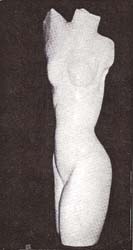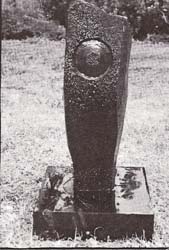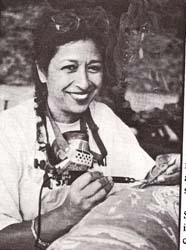I visit Sudha in her home near Wilsonville, Oregon. This is a spacious, light-filled contemporary-style home that looks like it was designed to display and enjoy art (Sudha designed it). It has a very open layout, with large windows that create an expansive sense of space. Sudha's paintings and sculptures abound and are displayed with their art collection. Mount Hood, in all of its splendor, can be seen in the distance across a rolling autumn landscape.
I am reminded of why I attempt to visit people in their own space/environment Simply experiencing a person's unique environment speaks volumes on who they are. As we view Sudha's large assortment of paintings and sculpture, it becomes clear that she is very diverse in both her art and her life and very at peace with it alL In her graphic work, she seems at home in several different styles; she works in very large and small scale (we look at her award-winning, 6'xlO' painting, "The Ganges'').
Her sculptural creations also cover a wide range. Stone carvings in alabaster, marble, chlorite, granite, jade, and basalt. She also works in ceramic, cast bronze, and most recently, glass. She seems to be an avid experimenter and learner. I came to talk to a sculptor and got a many-faceted creator who loves to cook and garden. She seems to allow herself to move with the creative impulse very effectively. I can't help but think she is something of a three-dimensional painting herself (she is often wrapped in silk "saris''). She has a gentle grace about her.
SS: What balance do you work between your painting and your sculpture?
SA: I don't have a plan. I just get into something, do it for awhile, then do something else. I have some very good work areas (an inside graphics area where she often works on the floor for large works, an area in the pool building where she paints and sculpts, a garage for clay and stone work and a barn for stationary grinding). But I don't like closed spaces when I'm sculpting, so I sculpt outside in the summer and I paint in the winter. That's how it worked out. With the breeze and the bird-song and the mountains, it's so inspirational. I just really love it.
I like to paint also. I belong to the International Experimental Society of Painters. You don't see anything traditional about my paintings. It's about freedom to create and have your own technique. There is an international show with members from around the world. They get together to paint and have a newsletter. They have regional symposiums. I go to Florida and paint for two weeks. All this is possible for me because of Patrick (Sudha's husband - both are psychiatrists in private practice). He is so encouraging. He's really my inspiration. If he wasn't behind me, I don't think I'd be doing all this. It's so demanding.
SS: And it sounds like you've found a personal balance with your art and your life. And having a supportive spouse is a god-send.
SA: He is so generous about wanting to make it happen for me. He covers my patients. He is so pleasant about me being gone, and then about coming to participate in my art activities and then the receiving hundreds of phone calls ... (An air of hawks soar by on the Oregon wind) I'm not under any pressure with shows and galleries so I do what generally pleases me. Fortunately for me, the galleries I'm in accommodate that to meet my time schedule.
SS: How do you organize your life? You seem to almost have three careers: psychiatrist, painter, sculptor. Anyone of those could fully engage a person. (Sudha even created a silk import business for two years.)
SA: People ask, "How do you do it?" It seems to come together. Sometimes I have to work at it, but most of the time it seems to fall into place.
SS: How long have you been doing all this?
SA: Painting ten years and sculpture eight years. I like to learn different techniques; glass fascinates me. It's like three-dimensional painting. Sometimes I think, oh, maybe I should put all my time into one medium, but I think I like the variety.
SS: What results from working in such different areas?
SA: My glass instructor aid my glass work was painterly. Others say my paintings are sculptural, which means you create a three-dimensional effect in your paintings. I guess one helps the other very much. Drawing certainly helps sculpture.
SS: Do you think drawmg can help when you're doing "direct" (spontaneous) carving?
SA: I like to direct carve. Sometimes I conceptualize the piece by drawing it from different views although it may not end up that way. I have not been successful at making a maquene; it's not my style.
SS: When did you move to the U. S.?
SA: 1973. I did my graduate work in London. I actually lived a few miles from Henry Moore. I'm really influenced by that group: Henry Moore, Barbara Hepworth, Jean Arp. My favorite artist is Antonio Guadi. He was know for his architecture. His architecture is sculptural. (She also mentions Donetello, Alexandro Pamodoro, David Smith, and Georgia O'Keefe.
SS: Do you find inspiration from Guadi's work in your sculpture?
SA: I think it's a summation of all these people I have admired.
SS: How did your upbringing in India affect your art?
SA: When I was seven, I remember looking up at an old temple sculpture and thinking about sculptors chiseling and making dust as they created these figures.
SS: How does your cultural experience affect what you do now?
SA: Being brought up in the sophisticated and cosmopolItan Bangalore area, I was encouraged to have the ability to do anything that can be done. Some of my paintings show the Tantric influence. (We walk around and view her art. We look at a piece of stone sculpture in yule marble, a 16" long "Lingmn" phallus shape - "part of the creative force." She tells about her adventure getting the piece through the airport x-ray machine and explaining that "it was just a stone." We look at a small standing figure in Colorado Yule marble, and "Black Iris" an abstracted lily form in chlonte.)
SS: What are your favorite stones to work with?
SA: Marble is my favorite, with all its colors. Even though I like the white marble, it's tiring after awhile. I like stone with more of the inclusions. And I like the harder stones: granite, basalt.
SS: Is there something about a stone that has more character, shape or color to it that might enthuse you to do something with it?
SA: I let the stone inspire me. (She tells about coming to her first symposium 1991/92 showing up in her silk shirt and red hat (trademarks) without any tools. George Pratt helped her get started and loaned her his tools. She chose to carve a face marble.) He has started so many people that way. That same year I went to the Marble, Colorado, symposium because I wanted to learn this. They gave me this 7' grinder and said "go for it" I didn't know any tools then. Initially I was intimidated but, with encouragement, I learned. (Most of the time, I liked using the 4" grinder.) I don't like to carve away too much stone. (We look at a female torso in realistic style with a dramatic opening to the abdominal area.)
SS: Is the opening a conscious thing or...
SA: It's just a "Iet-us-see-what-happens" thing. It's a free-associating thing.
SS: When you go back to it, does it have a rational meaning for you?
SA: It's a highly erotic piece. It was hard for me to do that (cut in the void because it was such a good figure form) but sometimes you want to not be so attached to that (perfect form).
SS: (We look at "Shiva", a male torso 3' tall in a thin slab of chlorite.) Your pieces have radically different styles. Why is that?
SA: It's a different day. It's a different me. If you watch the colors (in her painting), they're similar. I can't get away from that (brilliant primary colors) (We look at her fused glass, and small cast glass. She is excited about her recent experiments.)
SS: Do you have a preference in the sculptural media you use?
SA: I like stone a lot But then, I like the spontaneous too. And now the translucency and luminosity of glass is getting to me. (We discuss an alabaster figure "Parvathi" - Shiva's consort.) This piece evolved from the curved cut of the grinder mark on the stone into a torso form. At one viewpoint, it looks like there are two figures. That's what I aim for - a sculpture that has rhythmic lines from any angle. It doesn't matter if it has an identifiable shape or not as long as that works. That's what I'm interested in.
SS: So you don't have a clear preference between realistic and abstract style?
SA: I'm intrigued with the human form becanse of that pleasing line from all viewpoints. More so in the female form. (We look at her new fused glass panels and talk about their color.) That's how I see work in one media supporting the other. My interest in painting helps me with design. Glass, oh, it's fascinating. It reminds me of coming to the symposium for the first time and seeing all the different stones. I was like a linle kid following the piper.
SS: How do you find your art work relates to your work in psychiatry?
SA: They're very interrelated. They connect free association and logical thinking. A good physician is an intuitive physician. A great physician-scientist doesn't make a healing physician. A physician who blends the art of conveying his science to the patient makes a great physician. So I think it's absolutely interrelated. Also, I have the knowledge of so many souls, intimately, more than most people (having worked with many people). And that stays with me; it shows up in places I'm not even watching out for.
SS: Do you use drawing in your therapy?
SA: With children I use it a lot They don't know how to tell you their sorrows. But if you let them tell you a story about their drawing, you've got all that infonnation. It's non-threatening. You can talk in third person.
(We tour her carving area in the garage. We view several sculptures in process then move to admire her collection of stone: large pieces of jade, granite, many types and colors of marble, and basalt laid out for viewing around her outside carving area.)
SS: How do you do your lifting?
SA: All by hand with the help of others (often it's Patrick). Soon I'll buy an engine hoist. I'll learn how to strap and lift. I don't think there is anything like doing it yourself to learn how to do it. (We look at a 4' high triangular column of black granite and she describes her plans. "I'll leave it simple, work the edges, add a circle here, and polish it."
SS: Do you find the physical part of stone carving difficult?
SA: In medicine I got accustomed to being in a position of gi~ng. To ask for help is hard (in moving things and such), but I learned to get help. I'm now physically stronger than I've ever been in my life and I pace myself in the work, alternating tasks to ease the stress.

SS: How often do you work?
SA: Whenever I have time. It's actually in spurts, between traveling and other activities.
SS: It seems your whole story is about traveling, experimenting, learning and creating. Were you encouraged by your family to do art?
SA: More in the performing arts. My mother was a concert vocalist in Indian classical music. I can't carry a tune. I remember my father taking me to a local collection when I was a linle girl. There was a painting of a woman holding an oil lamp in which the lamp is burning, illumined. I went over to see what's behind the painting, lighting the lamp, and hit my head on the wall. It thought it was so beautiful that someone could do that. My interest was medicine at the time and my parents supported that.
SS: What are your major themes?
SA: The human figure. In my paintings a lot of times, the soul comes through. As the figure, it's the form and the line, the grace; I really feel it. In my abstract work, it is shape-for-shape-sake when I am sculpting the piece. But when I look retrospectively, the shapes seem to represent some part of the human body.
SS: What would you say the origins of your art are?
SA: I think it's the intuitiveness. It comes from the soul. And intellect defines it. But you couldo't do it from smarts alone. When you look at things in retrospect, you analyze and get insight into it. When I look back and think "why am I doing this?" I realize my philosophy of us being here is "have fun and leave the place a little more beautiful." I've achieved that in medicine. I've relieved pain and suffering and comforted patients. Hopefully in my art, I'll leave something behind. In my home life, I think I make Patrick happy. I do struggle with some of my art when it doesn't achieve what I want as soon as I want. In some pieces, pain does surface. As long as I'm not fully confident of the technique, then I'm conscious of what I'm doing. Once I know the technique, I let it happen. And then things show up. And most of them end up being an exuberant expression of myself.
SS: Thanks, Sudha.
Note: Sudha has been a board member for the 96-97 term acting as liaison to Oregon members and is just finishing helping review our bi-laws. She arranged and organized an upcoming stonecarvers show at the Oregon capital building. She also helped organize the last Silver Falls stone carving symposium at which she was an instructor. She is represented by Nancy Jordan, Inc. (Seattle), Art Inc. (Portland, Oregon), and Charlotte's Gallery (Sun River, Oregon). She has had shows at the Medical Association (portland. Oregon) and Intel Corp. (Portland. Oregon), and the State Capital Building (Salem, Oregon). She also shows with Sitka (a non-profit group promoting art and ecology).


